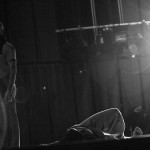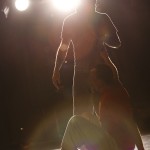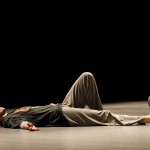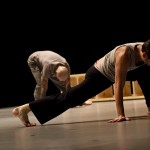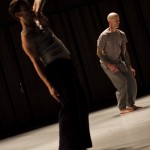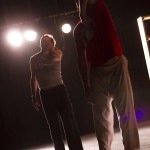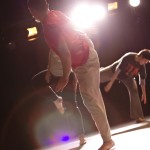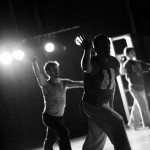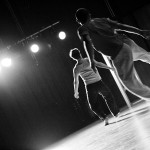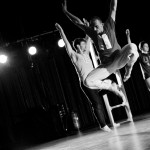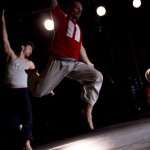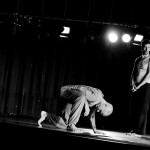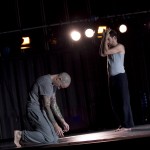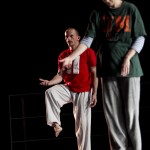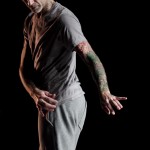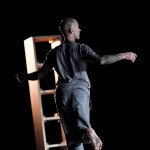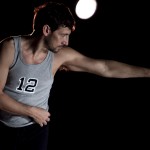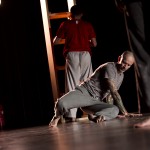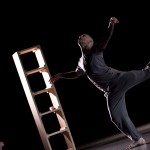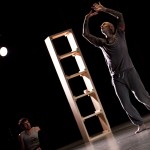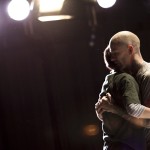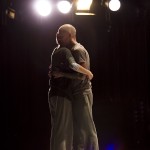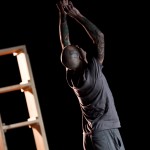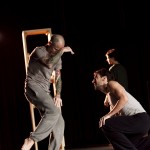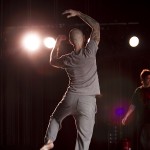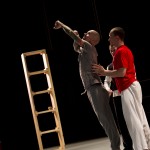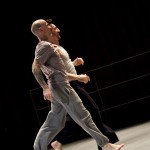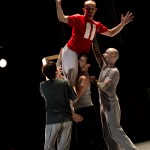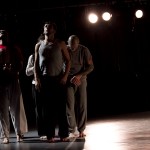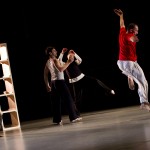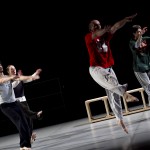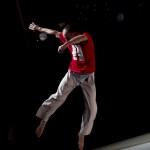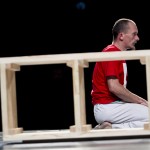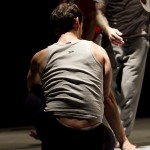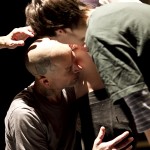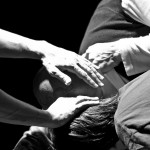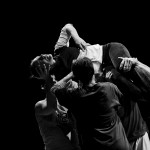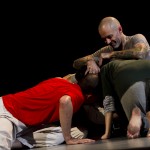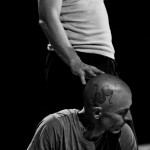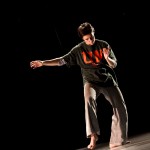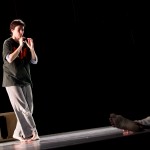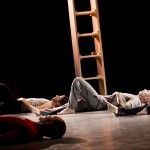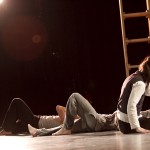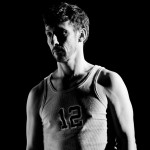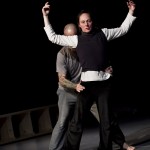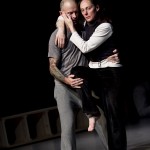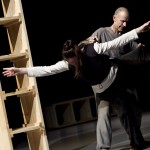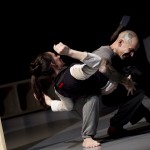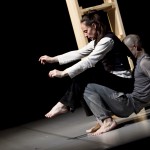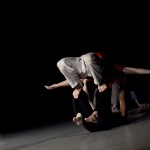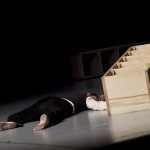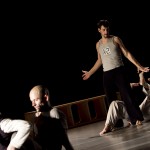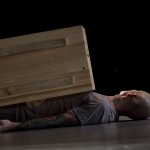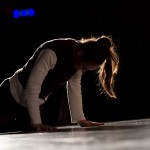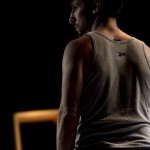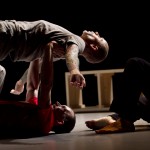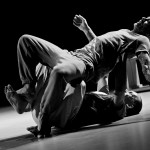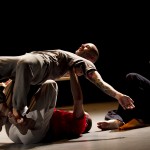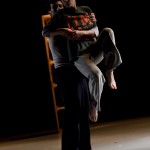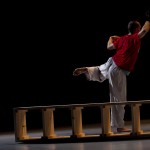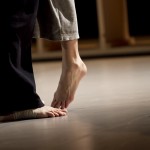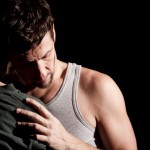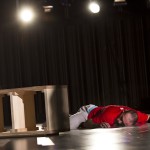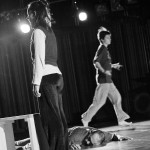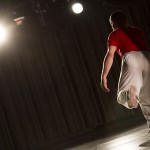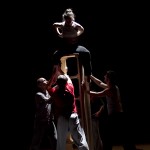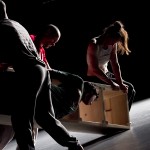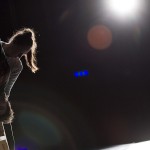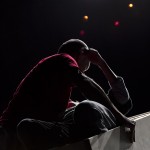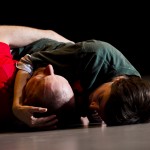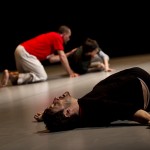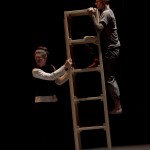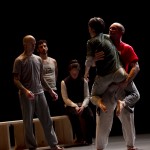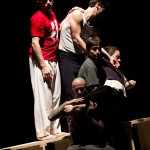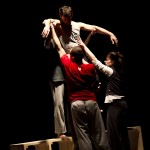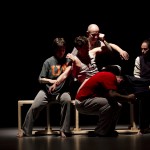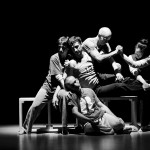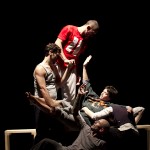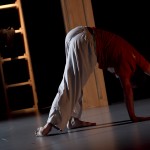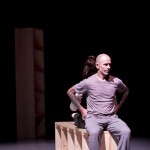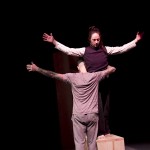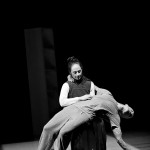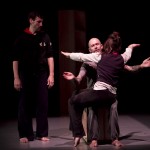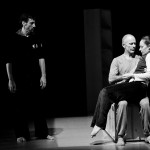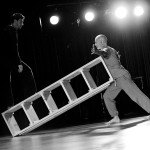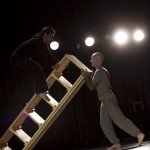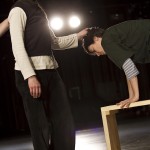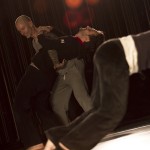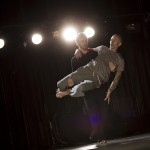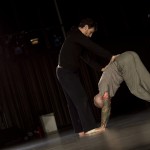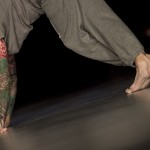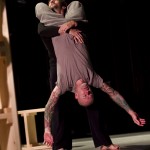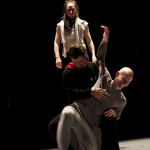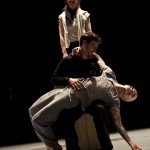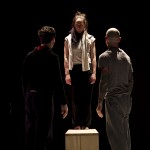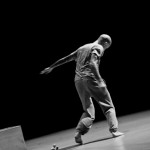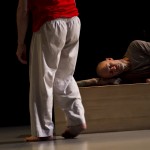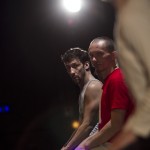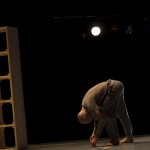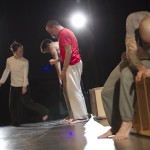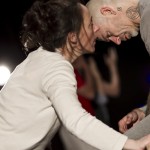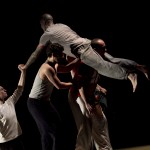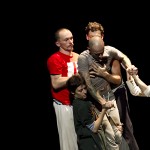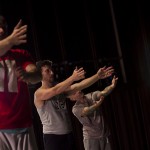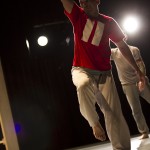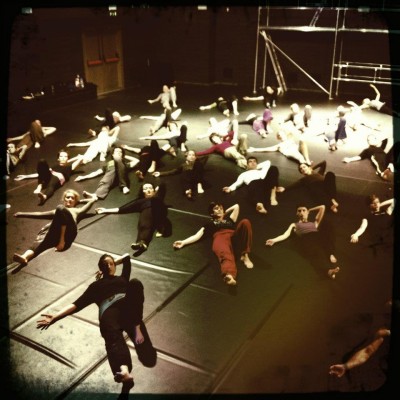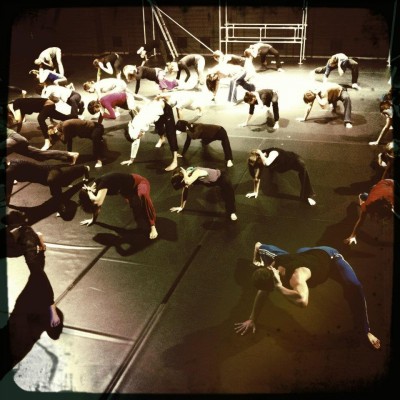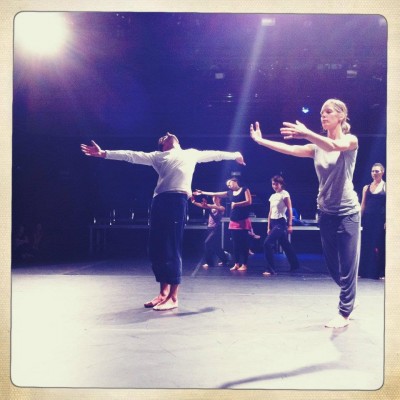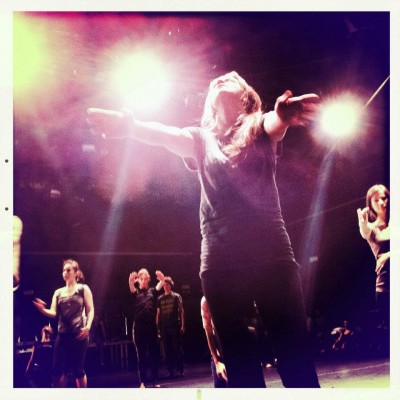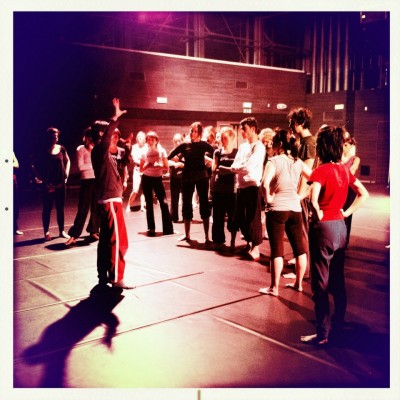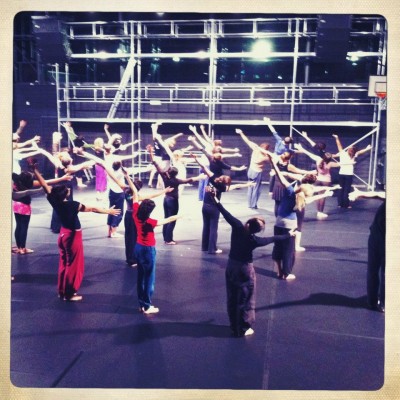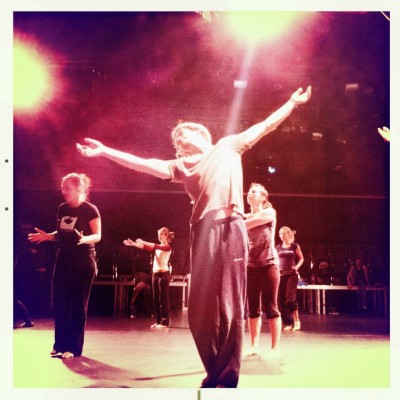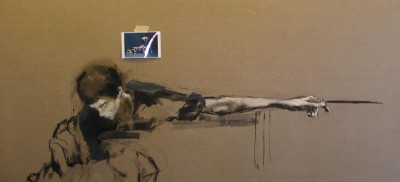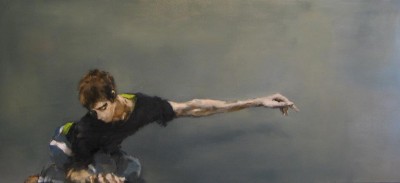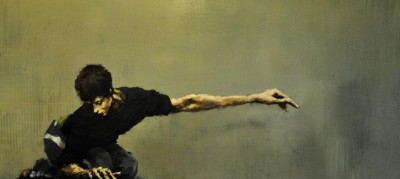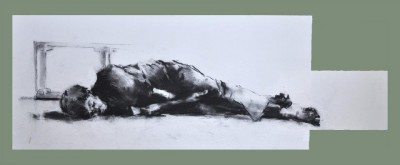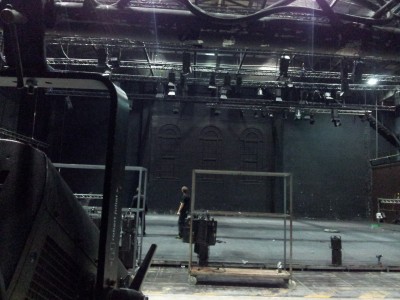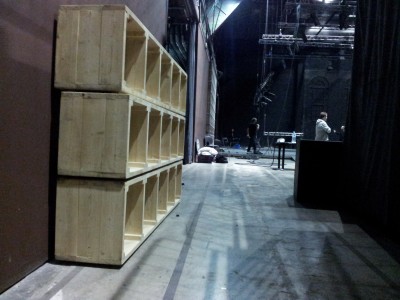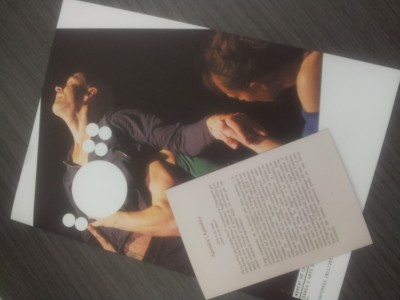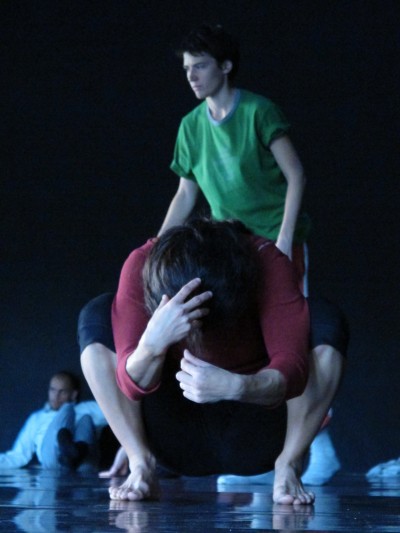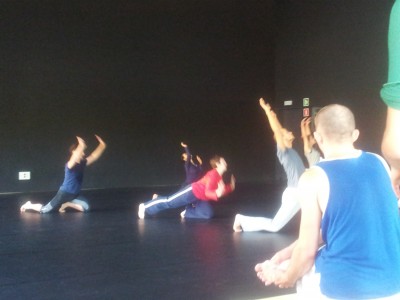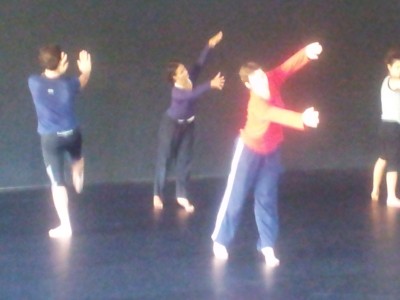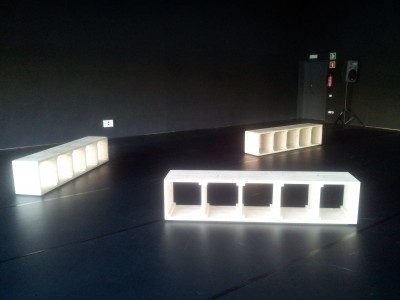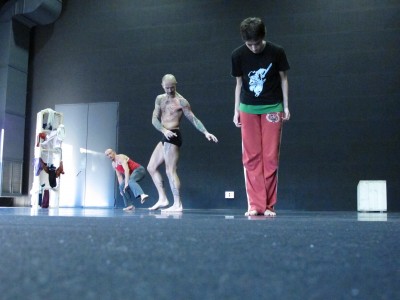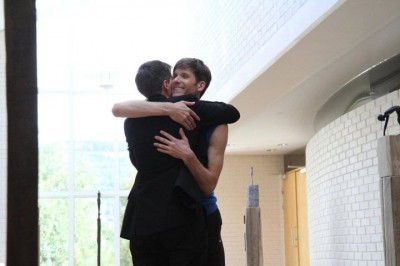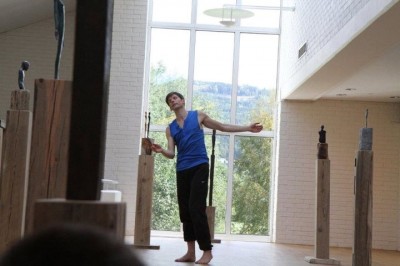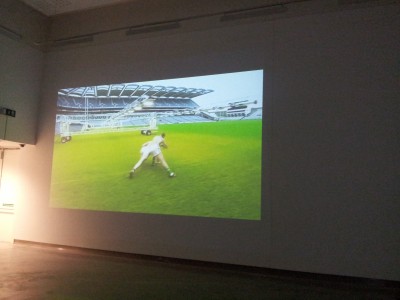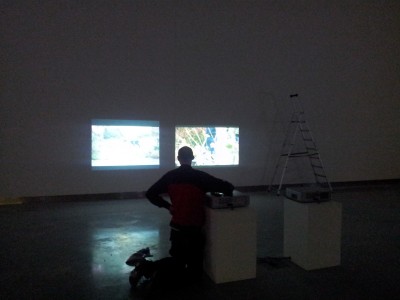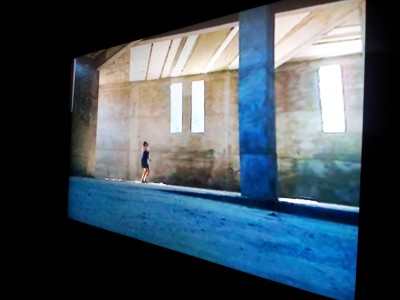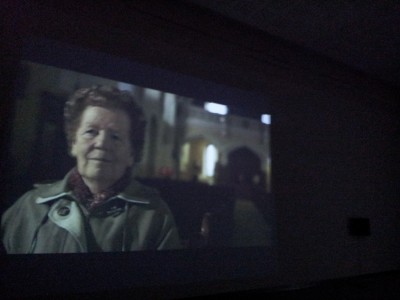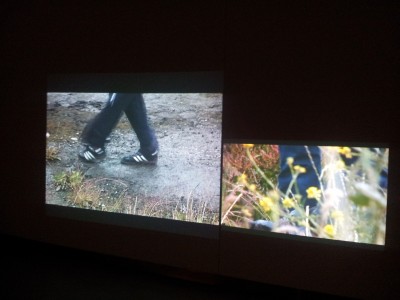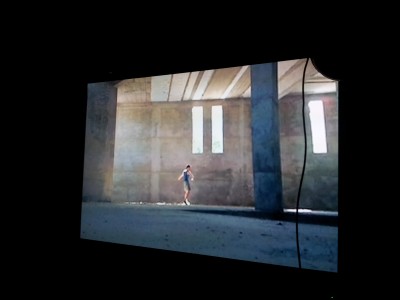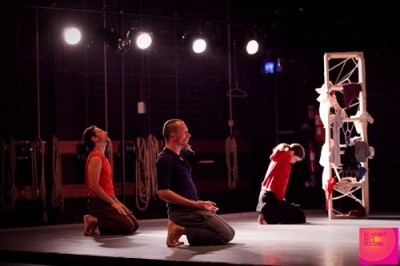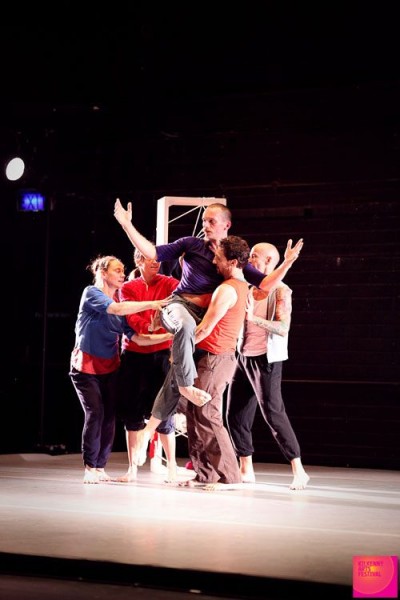Though the technical rehearsal went on late into the evening, David Lotric stayed with us and what his photos show me is that even when the dancers are not ‘performing’ they communicate simply and honestly the kind of humanity that Tabernacle values.
Yearly Archives: 2011
Tabernacle: After Ljubljana and London
My not having posted so much about the Ljublljana and London legs of the Tabernacle tour has causes that are prosaic and instructive.
On the prosaic side, I started to get tired as we progressed, particularly after the travel delay that meant that half of the group lost our rest day in Ljubljana. The dense fog that hung over the city didn’t help me have a clarity of perspective either. But fortunately the energy of the city, of Kino Siska, and of Goran Bogdanowski’s Fico Training group, of the Tabernacle team and of some artistically and gastronomically great cakes made some exciting things happen that these photographs of our workshops convey.
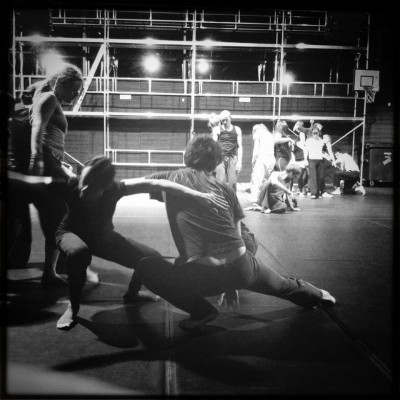
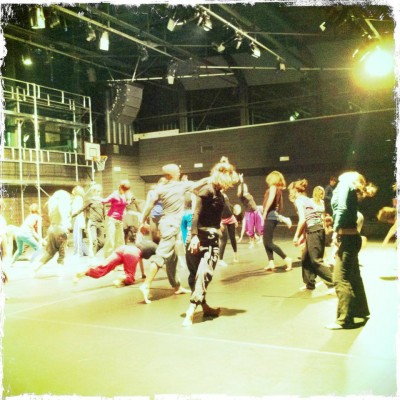
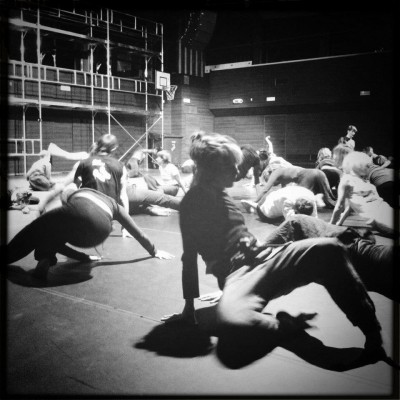
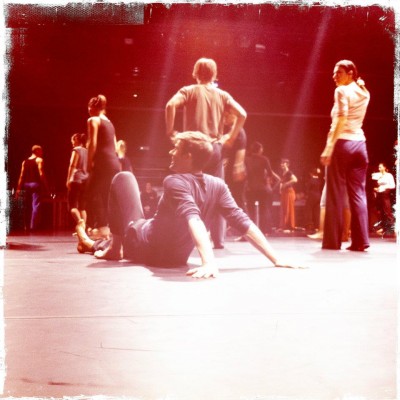
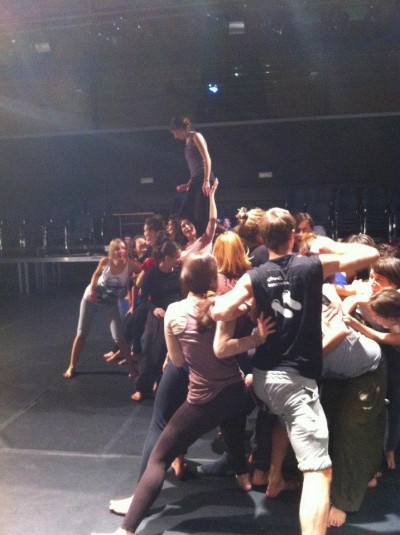
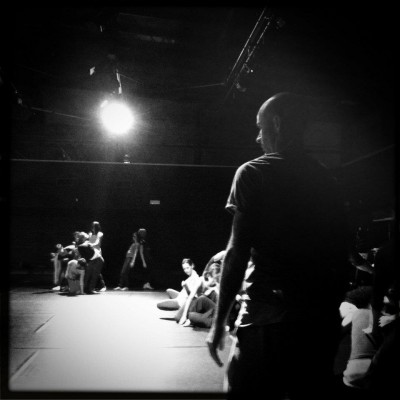
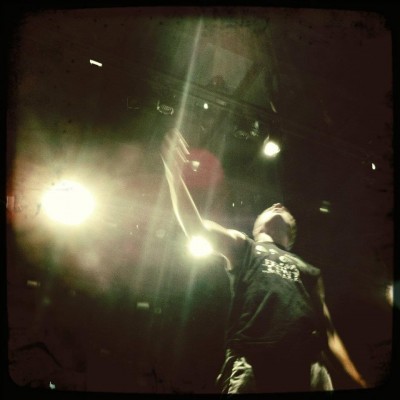
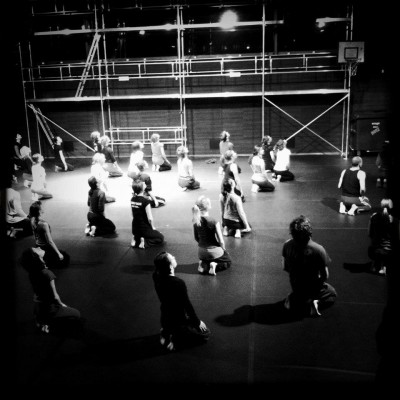
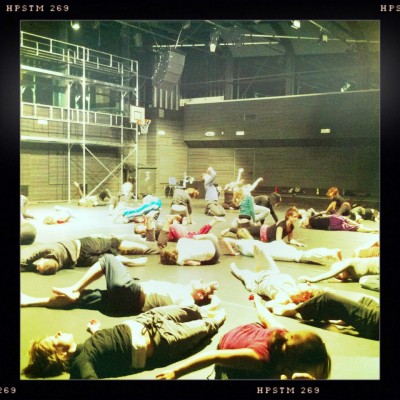
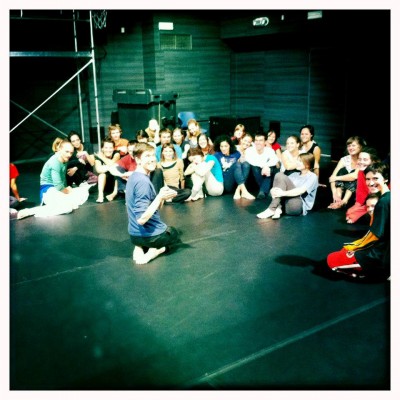
I think it’s pride that I feel when I see the Mo Mhórchoir Féin solo carried forward by almost 60 new bodies, and the engaged, creative response of that Fico Training group to the tasks we introduced. It and the workshop in Barcelona reminded me that the work is more than the performance. The performance is crucial in providing the heightened moment of focus that orients the rest of the work but it is not the work. Building a network, involving and engaging people, learning from them and sharing what we’ve learned with them – that is also part of the work. And it continues.
On the more instructive side, I haven’t written so much because I feel a bit talked out. The post show Q&A at The Place was very successful to the extent that people who attended were attentive and many spoke about how much they’d gained from listening to my talk about the work. But I fear that if I’m talking, I’m not learning. I’m not getting to hear the thoughts and responses of others. When a priest from the West of Ireland spoke of his difficulties as an out gay cleric in the Catholic church and thanked us for the catharsis and acknowledgment that Tabernacle represented for him, then I learned something.
So I think it’s time for me to be a bit quieter and to listen to the response to the proposition that Tabernacle represented.
It’s time to make some space for other people’s words and images:
Like Gabriel Schmitz‘s beautiful response:
And Tove Hirth’s sculptures to come:
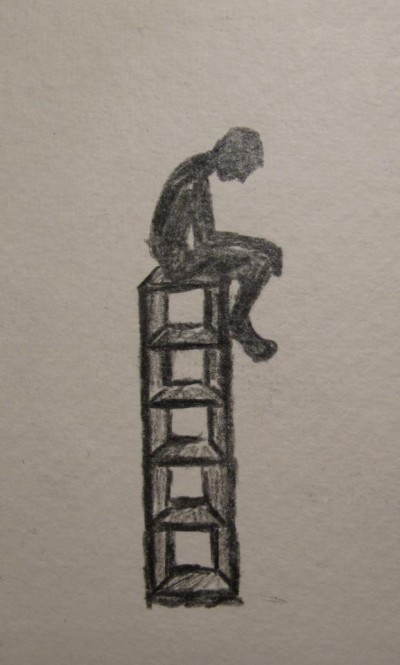
Mo Mhórchoir Féin wins audience award at the Capital Irish Film Festival
Mo Mhórchoir Féin shared the audience award for best short with David Bolger’s Deep End Dance at the Capital Irish Film Festival, organised by Solas Nua in Washington.
Fearghus was there to accept the award on behalf the whole team behind the film (especially director, Dearbhla Walsh and and producer, Maggie Breathnach), having been invited by Linda Murray to speak at the screening of Irish dance shorts on the closing day of the festival.
Both Mo Mhórchoir Féin and Deep End Dance were commissions for RTÉ’s Dance on the Box series made with the support of the Arts Council.
‘Catch me’: Mary Kate Connolly’s essay on text in Irish contemporary dance
With the speaking body comes a particular kind of signification and decoding. There is all at once the suggestion of narrative, and attendant expectations of ‘reading’ and deciphering. It is here that perhaps Ireland’s esteemed literary heritage can unwittingly disadvantage the world of the fleeting and intangible. Are we, as viewers within this canon, conditioned to seek the narrative, the decipherable in the dance?
Mary Kate Connolly is ‘a writer, researcher and movement practitioner’ whom Dance Ireland commissioned to write about the current state of contemporary dance in Ireland. She chooses to write about the use of text in Irish work and mentions among others instances the use of the phrase ‘catch me’ in Tabernacle.
Given my early academic training in literature, I’m very sensitive to any simple oppositions between language (do we mean spoken language or written? there’s already a lot of theoretical enquiry distinguishing between them) and movement, particularly those that posit language as permanent and reliable in contrast to the ephemerality and slipperiness of movement. There is also a tendency to equate thinking to spoken language (and there are lots of theoretical pitfalls in that), rendering dance a kind of impulsive, unreflecting activity.
Another article on The Psychology of Nakedness cites research into how much agency is attributed to people whose bodies are foregrounded – through baring flesh in their instance, but I’d argue the same applies to dancers whether or not they are sparingly clad since movement draws attention to the body that is moving.
Kant, for instance, argued that “sexual love makes of the loved person an Object of appetite; as soon as that appetite has been stilled, the person is cast aside as one casts away a lemon which has been sucked dry.” In other words, looking at a naked person filled us with sexual desire, and that desire induced a form of mindblindness. Instead of seeing the individual as having agency, he or she became a means to an end, nothing but a vessel for our satisfaction. Kant was describing a phenomenon known as objectification, in which seeing a body turns the entire person into a physical object. This idea is frequently invoked when describing studies like this, which found that women are far more likely to appear in magazine advertisements as an attractive body, while men are typically represented by their faces.
But the psychological reality turns out to be a bit more complicated. While seeing a body reduces perceptions of agency, it actually enhances perceptions of experience. As a result, Gray et. al. argue that objectification is a misleading term:
The idea that a body focus can lead to both decreased and increased mind stands in contrast to the term “objectification,” because it suggests that people seen as bodies are not seen as mindless objects but, instead, as experiencers: someone more capable of pain, pleasure, desire, sensation, and emotion but lacking in agency. In other words, focusing on the body does not lead to de-mentalization but to a redistribution of mind
What I am most interested in this article is not the distinction between body with agency (thinking, making things happen body) and a body that experiences things (which is the kind of thoughtless body, passively receptive to sensation that some theorists celebrate as escaping rationality eg Nietzsche). What catches my attention is the notion of the redistribution of mind, so that thinking is no longer the sole province of a mind imagined as residing in but irreducible to the physical mass of the brain. Instead the whole body becomes an agent of thought. And so dancing becomes a way of thinking.
So while Tabernacle might frustrate people who wish only to apply a rationalist thinking to seeing the work, it invites instead a thinking through the body. Not anti-thought but asking for a more whole-bodied approach to thinking.
Another article I read recently writes that To Dance is a Radical Act:
if we dance, and if we claim that dancing matters, then we are also affirming that we are not simply rational individuals whose best health is served by sitting and writing. We are bodily selves, sensing, feeling, stretching-and reaching for the knowledge, justice, and peace we desire.’
Again, it’s not that I want to endorse a mindless anti-rationalism. Rather I think that dance is important because it helps us to realise that ‘sensing, feeling, stretching and reaching’ through the body is all part of the mind and that thinking is deeper, rounder and more multi-faceted when it includes corporal knowledge.
Here’s Mary Kate’s article that covers many of the other interesting uses of language in Irish dance work this past year:
DANCING BEYOND WORDS
MARY KATE CONNOLLYESTRAGON:
Perhaps he could dance first and think afterwards, if it isn’t too much to ask him.
VLADIMIR:
(to Pozzo). Would that be possible?
POZZO:
By all means, nothing simpler. It’s the natural order. He laughs briefly.
VLADIMIR:
Then let him dance. (Act 1, Waiting for Godot, Samuel Beckett, 1953)iIt is unlikely that Samuel Beckett’s Pozzo had in mind the choreographic devising process when dispensing the above pronouncement. This notion of dance however, as impulse, as corporeally governed display beyond thought, is at first glance, a somewhat pleasing one. If we are to follow Pozzo’s viewpoint, we might consider dance as being before or beyond thought; untethered to weighty rumination. And within this framework, it becomes possible to replace the word ‘Think’ with ‘Write’. The impulsive body followed by the ruminating, reflective mind, and the written text. Now whilst this tenet may already seem problematic for a number of reasons, it is nonetheless often the order which is followed within traditional critical models, where writing comes only after the performed event, and where frequently, the writer is not the dancer/maker and vice versa. Within this model, rumination naturally takes hold, bringing with it a number of other characteristics which forge the shape and function of the text. And so the 5-star/raspberry award style of review is born, the breathless column inches of impassioned critics seeking to champion the artform in the face of an apathetic public, and the skilled swordplay of academia, where dance duels with philosophy, sociology, anthropology.
Whilst in no way seeking to undermine the worth of these forms of writing, it is perhaps little surprise that in the face of these traditionally imposed constraints, writing/dancing practitioners have long begun to excavate the ways in which dance and text can exist, interrelate, cross- fertilize, generate, and archive. It seems we have a predilection to make text and dance co-habit which could be viewed both as a match made in heaven, and as an altogether difficult coupling. Dance and text are not the same – they have different weights, depths, textures. They are ‘inhabited’ differently by the viewer. By persisting in marrying the two, do we risk both artforms coming off worse from the encounter?
This essay seeks to provide a brief survey of some writing/dancing dancing/writing strategies at work in current practice, and in doing so attempts to query why it is these two artforms continue to find one another. Why do we insist on writing on, around, from, and about, dance? What is at stake in these explorations, and is this the road to a happy marriage?Text as Archive/On Avoiding Decomposition
There is something about the weight of text which evokes in the writer a compulsion towards the archival. Text…feels…heavy-and-permanent. Posterity beckons. Textcanbamboozleanddazzlethereaderwithspeed. Or punctuate with a Pregnant…Pause. But despite the merry dance executed amid the tac-tac-tac of the computer keyboard, or the scratching of the pen as it scribbles, there is nonetheless a sense of permanence and ‘object’ to the finished product. There is evidence of what went before.
Dance on the other hand is weightless (in the sense of posterity), shackled not to the linear, or the indelible. Once embodied, nothing remains of its original form. In a discussion on what it might mean to ‘write with dance’, André Lepecki journeys back to describe the dilemmas faced by iconic ballet and writing pioneers such as Jean Georges- Noverre, who (according to Lepecki), cultivated an early understanding of dance as ‘elusive presence…fleeting trace of an always irretrievable, never fully translatable motion: neither into notation, nor into writing.’ii In charting the relationships between text and dance, Lepecki suggests that ‘movement is both sign and symptom that all presence is haunted by disappearance and absence’iii. Indeed there is an inherent sense of loss as dance, perpetually in flux, authors itself within an impermanent, unstable medium. In writing on dance after the performed event, there is an element of eulogising, describing, and documenting which takes place. Perhaps within these strategies, an attempt at resuscitation is to be found. This reviving is of course an attempt at the impossible: recapturing the elusive through the permanent will never succeed. Dissection and eulogy only occur when something is already dead. The dance has gone and the writer attempts to fill the void with words which re-author the past performance in a new and different medium.It goes without saying that dance texts do serve as fascinating archival tools. It is interesting to consider that the earliest ballets have solely text- based archives, which often have little to do with the choreography itself. The traces left behind might instead comprise of sardonic reviews by critics such as Théophile Gautier, laced with social gossip and value judgements of the era, costume notes and libretto, overwrought love notes sent to ballerinas in an attempt to woo, the assiduous directions of early dancing masters, written for the edification of their pupils in fusty tomes.
In writing on dance after the event, there are also a number of economic and social gains to be made; dance is disseminated, publicised, and therefore kept alive in public consciousness and debate. A validation of sorts is perpetuated in column inches, academic discourse, and blogs. Sadly however these archival remnants do not aid in the central struggle against loss. In charting the surrounding elements of performance, and replacing the live event with cumbersome metaphor, further distancing occurs, and as the gap widens, dance’s decomposition (in the sense of liveness), is established. An attempt at translation between mediums is perhaps bound to fail, when dance does not yield to the rules of language in the moment of afterthought.Writing Before the Dancing
But what if the order were to be reversed? Text as generative tool, rather than archival one. Many artists use text as a way into dance, rather than the other way around. The work of choreographers Emma Fitzgerald and Áine Stapleton is just one example of how text-based scores can be utilised to investigate the boundaries between writing and dancing, expanding the definitions of both in doing so.
Fitzgerald & Stapleton state that ‘The company’s choreographic process is rooted in the use of language to animate and direct the performer’s experience on stage and to celebrate the virtuosity of the body’s ability to perceive itself in relation to the unique and immediate physical and choreographic environments of each performance’.iv Within this working practice, text expands the notion of language choreographically; the body is spurred and moulded by the text. One could argue that it is authored by the text but perhaps in a ‘backstage’ sense. Text rather than embodiment comes first, so in a sense there is a notion of linearity to begin with, which then arcs and curves as it finds a resting place within the moving body. This is text written with the body in mind, an eye or a limb cast towards the physical structure that it may become.
In the case of work such as Legitimate Bodies’ 2009 production Hanging in There, a humorous duet which riffs on the political wordplay bandied about during the time of the Good Friday Agreement, an alternate approach is favoured. In this meeting of two worlds, there is a sense that the physical iterations of the spoken text illuminate with greater clarity the absurdity and the sense of precariousness which hovers within the trite politico-speak and bluff. Here the text, already in existence and written in an utterly different context, is subject to the will of the movement, which dislocates and rewrites it in a quirky guise.The spoken word is a regular feature of Irish contemporary dance; from ‘movement speeches’ such as those in Hanging in There, or Irish Modern Dance Theatre’s loquacious duet Actions (2010), to the sparse single phrase ‘catch me’ uttered mid-flight by the dancers in Fearghus Ó’Conchúir’s Tabernacle (2011). As text resides more and more prevalently in contemporary dance performance, it is worthwhile considering the divergent textures which it inserts within the space of dance. With the speaking body comes a particular kind of signification and decoding. There is all at once the suggestion of narrative, and attendant expectations of ‘reading’ and deciphering. It is here that perhaps Ireland’s esteemed literary heritage can unwittingly disadvantage the world of the fleeting and intangible. Are we, as viewers within this canon, conditioned to seek the narrative, the decipherable in the dance? In the case of Beckett’s Vladimir, Estragon, and Pozzo, they are no friends of decipherability. They evade deconstruction, invite familiarity without linearity, and lead the viewer along winding tracks to a place of non- sense. And yet there is text, a speaking body; for the viewer perhaps this offers a sense of knowing, an ability to offer judgement. They are after all speaking in the same ‘language’. If we apply this quest for story and narrative when we experience dance, are we lost before we begin?
Within this conundrum, the opposing weights of dancing and writing are once again in evidence. There is a reciprocal authorship between text and movement, and a careful balancing act must be negotiated to avoid one smothering the other. A particular craft is evident in works which traverse along these lines and allow both dance and text to thrive. The literal physical metaphors in the counterbalances and bodily knots of Hanging in There serve to make the text dance, providing a physical architecture to otherwise solely conceptual language. In the case of Ó’Conchúir’s ‘catch me’ phrase, playful physical falls and swoops are rendered immediately vulnerable by this single utterance, in a way that perhaps only the spoken word can facilitate. With each new encounter between dance and text it seems the battle lines must be re-drawn, the weight of words tested anew.
Dancing Writing
In the same way as the presence of text can sculpt dance, so too can the relationship be reversed. Jeffrey Gormly writing in his essay on solo practice outlines a state of dance as ‘a state of mind|body|mind that is in love with movement’.v In embracing a state of dance in writing, there is the capacity for side-stepping, for recourse to the immersive and embodied; writing becomes [almost] loosed from the linear.
This state of dance as a construct in dialogue and writing is undoubtedly a fruitful one. The concept has extended to exploratory labs and workshops such as Gormly’s Thinking Talking Writing Dance, a roundtable strategy of devising/discussion conceived by Gormly and hosted by Dance Ireland. Drawn from influences such as Steve Valk’s Raw Thinking Circle (developed at Daghdha Dance Company), and ‘Creative Recovery Programmes’, Thinking Talking Writing Dance ‘evolved out of the desire to discover a container that will accommodate working ideas of a group of people, entitling sovereignty and autonomy (i.e. authorship) to each person’s train of thought, while also facilitating movement within and between’.vi
Articulating a state of dance inspires flexibility, fluidity, shifting, and flux in the writer. A certain freedom from the texture and permanence of the written word is induced. Perhaps circumventing, obfuscation and the ability to connote, rather than denote, is afforded when we think of dance; a sensation of weight transference and exchange of ideas. One could argue that these characteristics offer an escape route from some of the central facets of writing, the indelible, weighty ones, that is. Perhaps here we find illustrative evidence of the reasons why dance and writing continuously seek one another out. Perhaps it is the old cliché that opposites attract.
In the (albeit awkward) coupling of text and movement, both are allowed to shed some of their features and exchange them for ones of a different nature. Thus dance perhaps gains a small, novel measure of linearity or signification in a different form, whilst writing attains a hint of the weightless.Towards and away, towards and away
Accepting the grounds for attraction between these two creative mediums, the capacity for mutual destruction within this marriage of dance and writing seems nonetheless undiminished: a need for balance prevails. In seeking to establish a critical discourse for example, a dilemma emerges for the writer; that of the need to serve/illuminate the dance of which it speaks, but not at the detriment of the text. Inviting a state of dance allows a certain flexibility but does not resolve the problem altogether.
Similarly, dancers/makers may seek to hone the written word as a tool to serve, but not to dominate, the dance. Within the working process of dance-making, text can operate on numerous levels – from the scribbles in a choreographic notebook, to the ad-hoc written score used to document, or generate material. Whether as generative device or archival resource however, writing is usually required by dance makers to partner the movement, without crushing its vital ephemeral nature. There is ever-present the potential for loss in this delicate exchange; just as dance loses itself as it is executed, so too is that loss reinforced by the permanence of the written word which remains in its place.
Writers move towards a state of dance. Dancers write within the dance they author. It seems these weight shifts will be ever fruitful, ever perilous, never even; dancers and writers alike moving towards and away, towards and away…One Final Thought
In exploring the different ways in which dance and text can interact, mutually influence, and co-habit, the benefits of attempting to write dance are evident on both sides. In addition to the economic attractions of exchange and dissemination, there is yet further a strong compulsion to talk about, and write about dance, whether within critical discourse or as a dance-maker. Despite the reasons outlined as to why this may be so, the attendant pitfalls continue to play on my mind. In spite of my own impulse to write on dance, I remain deprived of an entirely satisfactory basis for all this writing|dancing|dancing|writing.
Why is it that we all persist with the tac-tac-tac and the chat-chat- chat? Now at the end of my ruminations, I begin to wonder whether in fact we write to discover dance, to further a journey towards a state of pure dance. A state which might after all, resonate with Pozzo’s concept of dance…
Is it all in fact a side-step towards speechlessness, where words – impotent, unwieldy and overly burdensome – are no longer needed? Perhaps as writers and artists, we are striving to be cradled in the moment of performance, where breath is caught, meaning immersive but joyously opaque, words silenced.
␣
␣
On Generating an Archive:
Writing this it is now two years since Michael Seaver records in his essay (Counting Capital: The Real Value of Dance in Irish Society) that Ireland is in the grip of ‘severe flooding’, and increased funding cuts. It is one year since Jeffrey Gormly (in Everyone is Going Solo, Together) notes that ‘our worst fears have been realised’, along with ‘a savage winter’. Now it is my turn. I feel a need to chart time. With summer now firmly turned towards autumn 2011, the Presidential election race shifts up a gear, and economic woes remain. But dance is far from invisible. Whilst instability prevails, innovation and side-stepping continue. Recent new productions from companies such as Rex Levitates demonstrate a resilience in the sector, and the bustling turnout at Dublin’s Grand Canal Theatre to see Cloud Gate Dance Theatre of Taiwan (during the May Dublin Dance Festival), serve to illustrate a mass audience for dance, despite the grim economic realities.iBeckett, Samuel (1956, 2010 ed), ‘Waiting for Godot: A Tragicomedy in Two Acts’, Faber & Faber: United Kingdom
iiLepecki, André ed. (2004) ‘Of the Presence of the Body: Essays on Dance and Performance Theory’, Wesleyan University Press: Connecticut, pg 127
iiiIbid, pg 128
iv www.fitzgeraldandstapleton.com
vGormly, Jeffrey (2010), ‘Everyone is Going Solo, Together’, published by Dance Ireland
viGormly, Jeffrey, ‘choreography: a thinking talking writing dance’, www.choreograph.net
␣
␣
Irish born Mary Kate Connolly is a writer and movement practitioner based in London. As Programme Leader for the Masters Degree in Creative Practice at Trinity Laban Conservatoire of Music and Dance, London she lectures on a number of Undergraduate and Postgraduate programmes. She writes freelance for publications in the UK and abroad. Formerly Company Manager for iceandfire
theatre, Mary Kate has worked as a movement director for a number of theatre productions in London. She is currently undertaking research into the relationships between costume and performance, in collaboration with the Victoria and Albert Museum, and London College of Fashion.
Commissioned by Dance Ireland, Dancing beyond Words is the third in a series of essays leading up to the organisation’s 21st anniversary celebrations in 2013.
www.danceireland.ie
www.lucatrufarelli.com
Tabernacle in Barcelona: The performance
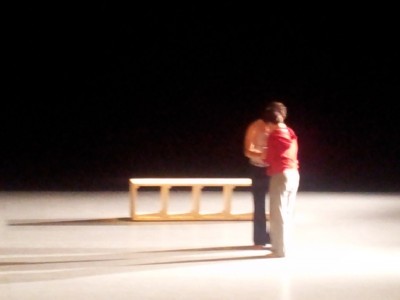
I’m writing this post after midnight in the A&E of Barcelona’s Hospital Clinic where Mikel is having his ankle checked having twisted it at the start of tonight’s performance of Tabernacle. Watching the show I knew he was more physically restrained than normal but didn’t realise that he’d hurt himself in the show. Adrenaline proves a powerful anaesthetic. Mikel managed a particular physical challenge tonight but all of the dancers make their own negotiation with discomfort and pain to allow the piece to emerge. They are brave and generous in what they offer up.
It was exciting to present Tabernacle in the vast space of Mercat’s Sala MAC. The space was built originally for an International Expo in 1929 and was a home to Peter Brook’s work for many years (so a sacred space of theatre already.) Like in previous performances I wanted to remove all the masking from the space. In Sala MAC, the resident technical team were reluctant to do that given that most performances use masking to create a black box or proscenium space in the hangar-like room. But we removed all the black masking, stripped the theatre back to walls, concrete and iron struts and presented a luminous Tabernacle on a big grey floor (15m X 10m) that was small in comparison to the airy, open darkness that extended around it.
I stuck to my instinct to strip back the masking when the Mercat technicians queried (out of genuine concern I think for the quality of the presentation) that decision. But I did wonder whether I was wrong. Seeing how beautiful the piece looked in Sinéad Wallace’s lighting reassured me, as did Sarah Browne’s observation that I have been concerned with transparency throughout this process and that the decision to remove the masking was therefore a necessity. It’s great having someone whose proximity to and distance from the work gives her a clarity of perspective that I don’t possess.
Tabernacle in Barcelona
For the past week, Tabernacle has been in residency at El Graner in Barcelona, a brand new space run by Mercat de les Flors where we perform this week. El Graner is in a refurbished Phillips lightbulb factory and we’ve been working in a huge studio with a suitably cathedral-like height.
When I was organising this residency, I wanted to use it as an opportunity to continue refining Tabernacle – so that it does not become a fixed product continues to evolve as a living process. For that reason, I also wanted to make a connection between the work and the place where we would perform. So through Mercat and El Graner, we organised a free workshop for local dancers. I specify free because when we finished the workshops yesterday one of the dancers thanked me for having something for free in this time of high unemployment and economic difficulty in Spain. Though such work is never without cost – though that cost was born by Culture Ireland, modul-dance and Mercat de les Flors and Project Art Centre, in this instance.
Things the workshop has taught me
1. It’s the shape it is because it was necessary
By which I mean Tabernacle grew gradually out of the coming together of the people (dancers, collaborators, visitors) that I invited into the space I created under the title Tabernacle. To give the workshop participants here in Barcelona a sense of the truth of the work, and not just a picture of the form that emerged from the process of creation, I wanted them to get a sense of the diversity of people who have come together to create the work and for those Barcelona participants to realise that they too have entered into it.
For the five days of our workshop, each of the five Tabernacle dancers (Matthew, Bernadette, Stéphane, have led the warm up and exercises that share something of their journey through the piece. They’ve also taught my originating Mo Mhórchoir Féin solo as the point of departure that they share for their path through the work. And Sarah Browne who is here to make a new Appendix for the performances of Tabernacle at Mercat de les Flors also spoke to the participants about her involvement in the process, sharing images and setting a stimulating task for everyone to imagine what it would be like to have the body of a saint.
Early in the week, I was anxious that the change of workshop leader each day, the change of focus, change of movement style, change of entry point into the dance and creativity would be confusing and unclear. But little by little, I realised that the variety of perspectives meant that the many dimensions of Tabernacle, its open, multi-faceted structure had to be conveyed by this kind of approach. No one of the dancers can communicate the whole piece though each carries an essential element of it. And each brings something of me to the piece so that through them and their differences, I recognise myself in the work though I don’t dance in it.
2. You don’t find community, you make it.
By the time we finished the workshop yesterday, it felt like we had built a new, albeit temporary community with these dancers from Barcelona and that the existing group of Tabernacle performers had had a chance to deepen its connections internally by extending outwards to other people.
To end the workshop the dancers did a run of Tabernacle in the studio but with the local performers joining in the solo that starts and ends the piece. It was particularly moving and joyful for me to have the participants follow the journey of the piece by watching it and then stand up to join in the dance that ends the piece. In Dublin, I imagined that kind of participation but couldn’t imagine the process that would allow it to happen. It is wonderful that the workshop and residency here has given me that though I hadn’t planned it to do so.
It’s also great to know that when we perform in Mercat, there will be friends already in the audience who can extend the Tabernacle community beyond me and the Tabernacle dancers.
Dancing at Tove Hirth’s sculpture exhibition
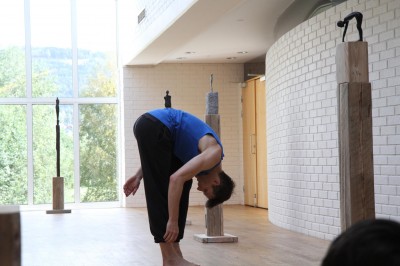
Tove Hirth and I have been friends since we met at Pearson College in Canada in 1987. I think we both discovered our art forms at Pearson, me dancing in the Theo Dombrowski’s Ukrainian Dance Group (and as I write this I’m claiming that title for future work!) and Tove in Fleming’s art classes. Over the years she has drawn me dancing many times and used the drawings as inspiration for her bronze sculptures. Her tall etiolated figures resemble my long body. So when she asked me to come to the opening of her new exhibition in her home town of Jevnaker I was very happy to make the trip.
I danced at the opening and found myself still delighted to be able to do so after the knee surgery. It may be a bad thing to admit but having faced the possibility that I wouldn’t dance again, I am doing so now with much less anxiety about how it looks and whether it’s good. I dance now because I want to and I can.
The opening was a great success: the quality of Tove’s work, the beauty of the environment, the care of those that helped Tove and Tove’s own ability to draw people close to herself, connecting one to another generously all contributed to that success.
Some other things impressed me also. The exhibition took place in a beautiful space in a hotel and conference centre. The fact that it didn’t happen in a conventional gallery space meant that people who might not ordinarily stop to look at art did so. The fact that these people could get a sense of the working process behind mounting an exhibition also allowed them to connect more with the work. And Tove is very generous in engaging people in conversation to explain her work. If she presented this work in a conventional gallery, all of this preparation would take place ‘behind the scenes’, ‘out of shot’ and only people who felt comfortable entering a gallery would find the sculptures and drawings. By mounting her exhibition in a hotel she has created new possibilities for her work and for people to gain something from it. It’s a way of engaging with an audience that suits her and feels familiar to me.
Rua Red: Bodies and Buildings film exhibition
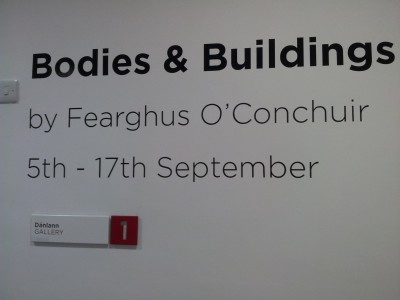
The facilities of Rua Red arts centre in Tallaght have been a discovery for me. I’ve spent a week there mentoring the Dancer in Residence for South Dublin County Council, Louise Costelloe and also installing an exhibition of my films called Bodies and Buildings. My time has been divided between the light-filled studio, the huge exhibition space, the technology-rich Mac room and the pleasant cafe. There are music rehearsal rooms, offices, and a performance space in the building too and it seems like they’re being used. Some of the regeneration initiatives in Tallaght have stalled leaving empty apartment blocks, unfinished squares and facilities that don’t quite have the operational budget to activate the infrastructure.
All of this provides a suitable backdrop for my Bodies and Buildings exhibition. It’s provided an opportunity to assemble and display a range of films that I’ve made since 2006, from the low-res footage of me dancing in Dublin’s Docklands, Shanghai’s demolished hutongs or the unfinished art spaces of Beijing to the polished Match and Mo Mhórchoir Féin made for television. The low-res films, captured on my phone’s video camera, began during my residency with Dublin City Council when I first started to think about the relationship between bodies and buildings in the context of rapid urban regeneration. The exhibition allows me to show the arc of that research, nationally and internationally, and to link the very direct investigation of the body/my body on building sites and street corners to the work in Croke Park or a Catholic church.
Tabernacle at the Kilkenny Arts Festival
Performing in the Kilkenny Arts Festival has been the start of working out how Tabernacle continues beyond its initial performances in Dublin last May. It was my first visit to the Festival and it’s wonderful to see how a beautiful city welcomes a wide range of art forms. It’s been a very positive experience to have been programmed to present the work again and I’m very grateful to Tom Creed for having been willing to take that programming decision before Tabernacle was was even made. His confidence has ensured that the work can build a momentum of interest in the audience and hopefully ensure a longer life for Tabernacle.
There were challenges to presenting the work in Kilkenny. The Watergate Theatre has a smaller stage that Project’s and a proscenium arch that sets the work at a distance from the audience. In fact the work looked good in Sinéad’s revised lighting design but we still had to address the potential separation between performance and audience that we’d worked to avoid in Project. In Kilkenny, we didn’t have the chance to have open rehearsals or a local engagement that would help us feel connected with our audience in advance of the performances. However, we were lucky that many friends traveled to see the work so, in the end, we did have a community of support around the work.
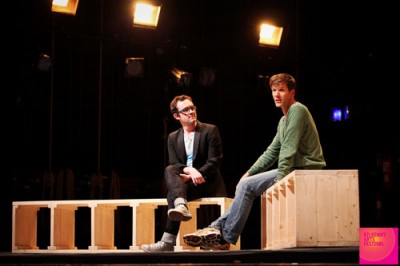
The work was well received, as this review indicates but that doesn’t mean that it was an easy experience for audiences. When we had a post-show discussion last night, I was very aware of how people responded to the beauty of the images in the work and to the skill of the dancers, but how they were troubled by what they didn’t understand. People asked about having information or notes in advance to help them appreciate the work. I heard in their concern to understand a respect for the work and a belief that it was worth delving in to. But I also heard some frustration at not being told clearly what was going on.
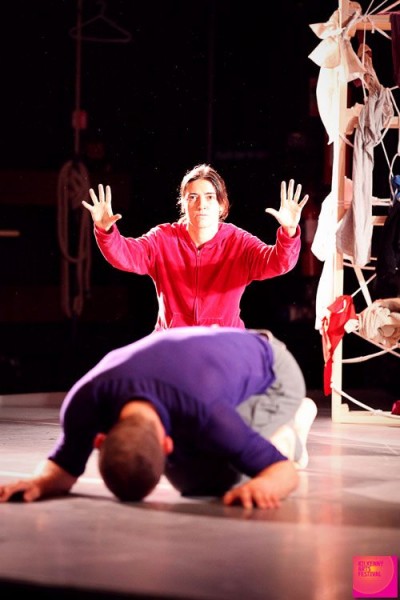
I was troubled by a suggestion that the audience was excluded from the process that was more concerned with the experiences of the dancers and me. That suggestion bothered me because it is the opposite of the openness and welcome I’d wanted to extend. There is no dogma, no message because I want to invite people to make their own place in the work, in relation to it.
However I realise that some people find that openness too challenging. They feel that I am shirking my responsibility in some way by not signposting more clearly my position. Perhaps this non-directed openness is my position. I know that it is challenging. I know that I am asking an audience to work hard. But the dancers work very hard and we – audience and performers and I – make this work together.
Glenstal Abbey
I hadn’t been at Glenstal Abbey since I was 14 and I cracked my cheekbone playing rugby for my Cistercian College Roscreal against the Glenstal school team. I’ve just spent two days this week participating in a workshop at the abbey that foregrounded my body again? The workshop had been advertised as focusing on Music, Mysticism, Religious Imagination and Ritual but by the time I got there, it had, with a generosity and openness that I admire in the Abbot Patrick Hederman, transformed into an exploration of the body and religion. Though there was a lot of thoughtful discussion, the workshop placed art – music, visual and choreographic – at the heart of expression.
It was a pleasure for me to arrive in the middle of day two and find myself in a singing session with Noirín Ní Riain and Micheál Ó Suilleabháin, connecting me to the first time I encountered them in the sevntieswhen they lived in Ring (where I grew up) and led the choir there. This was just the first of many powerful serendipities.
One of the novices at the monastery, Emmaus O’Herlihy, is an artist and with the encouragement of the Abbot he has produced an exhibition of striking paintings that
‘endeavors to bear witness to the challenging declaration of faith in a God made man, whose life, suffering, death and resurrection insists that our salvation rests in embracing Him in our human condition—not apart from, or in spite of it : In Tertullian’s lapidary phrase Caro Cardo Salutis (The flesh is the hinge of salvation’.
While I don’t have the confidence or perhaps the right form of faith to write in these terms, I was moved to tears seeing Emmaus’ paintings. They are depictions of the creation of Adam, of Saul’s conversion, of Christ risen and of the beloved disciple. And they are also images of male physicality, of human suffering and of desire. The holiness they seem to endorse is one that is inseparable from flesh, desire, beauty and suffering. I might not share with Emmaus a religious language to talk about the work but I feel a strong kinship between our artistic expression and its acknowledgement of the necessity of the body to understand the spiritual. I was amazed to see in his depiction of the Beloved Disciple the same open mouth, upturned face and receptive hand that features in Mo Mhórchoir Féin and in Tabernacle.
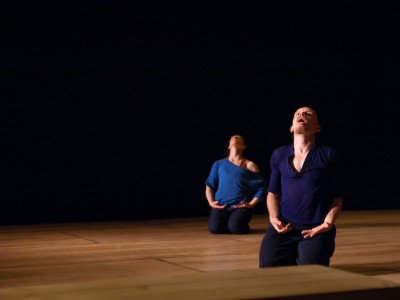 [/caption]
[/caption]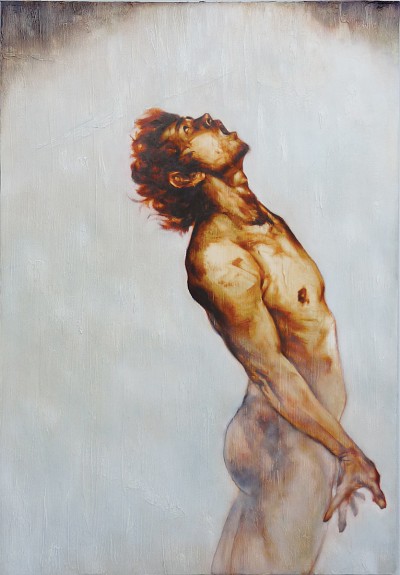
Fr Gregory, one of the abbey’s many theologians, spoke of the abbey as a refugee camp for those damaged by Irish Catholicism in recent years. Given that the Tabernacle was for the Jews, a kind of tent into which God came to communicate with them, I am already a fan to the kind of mobile nomadism that the refugee camp implies, even if there is a trauma that brings the refugees together. But I also see Glenstall as a laboratory, a place of exploration and possibility where a new articulation of possibilities might emerge. It feels like a place where spirit, body and mind might all be honoured.
It’s not easy to write about this. It feels exposing and embarrassing and not at all cool. But in the wake of the Cloyne report which revives the pain of betrayal felt by many in Ireland in relation to the Catholic Church, openness, even about what is not cool, not comfortable, not dignified feels like the only ethical strategy for going on.

